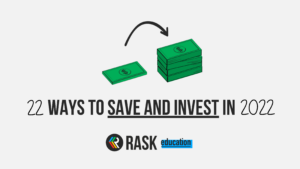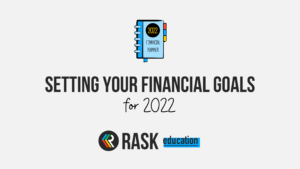This Rask Tutorial answers: how do I invest in ASX shares and Australian ETFs to make passive income and growth wealthy. It explains the difference between growth investing and dividend income investing.
Over the long-term, such as 5-10 years (or more!), most Aussies and Kiwis invest in ASX shares for two reasons:
- Capital growth (i.e. stock prices going up), and
- Dividend income
What is capital growth?
Capital growth refers to an increase in the price of an investment over time. For example, if you buy shares of XYZ Company Ltd today at $5 per share, you would hope it goes higher over many months or years.
Dividend income is, as the name suggests, about earning income in the form of dividends from your investments.
Oftentimes, investors will favour one type of investing, growth investing or income investing. For example, a person in or near retirement might be more interested in a reliable income stream whereas a younger investor who’s willing to take on more risk might favour faster-growing companies.
What is growth investing?
It’s important to know that growth investors want to see their share prices go higher over time (i.e. from one year to the next). However, in contrast to traders, growth investors focus on the business’ growth.
The types of things a growth investor will focus on include:
- The industry. Many growth investors want to invest in shares with an industry “tailwind”. That is, they try to own shares of companies operating in industries that are growing (e.g. online businesses, technology, healthcare, etc.).
- Sales/revenue growth (from one year to the next). A growth investor will find out why sales are rising.
- Profitability. Often, a growth investor won’t need their companies to be making a profit right now. Instead, they are focused on what the company could become.
The important thing to remember about growth investing is that share prices can sometimes take years to catch up with the growth of the underlying business.
For example, some of the greatest growth companies have had their share prices sold down or punished from one year to the next for bad performance. The trick is finding companies that can grow their profits sustainably for many years – sooner or later the share price will catch up.
Investing in ETFs?
Growth investing can be done via the use of Exchange Traded Funds or ETFs. Most share ETFs benefit from all shares in a particular market rising over time.
What is an income investor?
Income investing is very much the same as growth investing but with two minor differences:
- Income investors typically target mature businesses (i.e. those already making a profit).
- Income investors place more emphasis on the current dividend of a company.
For example, an investor looking for income from the sharemarket will probably want the company to pay a dividend equivalent of 2% – 5% (or more) of the share price in the next 12 months.
For example, if a company expects to pay a 20 cents per share dividend in the next 12 months and it has a share price of $5, that’s a dividend yield of 4% ($0.20/5.00 = 0.04).
Remember, dividends are not guaranteed.
If you’re looking for dividends:
- Consider focusing on large and financially strong ‘blue chips’
- Look at the company’s past track record for dividends. Is it likely to pay dividends in the future?
- Is the business making a profit? If it is growing or makes consistent profits, the company is more likely to keep paying its dividend.
Can I have both: growth and dividends?
A common misconception about investing in shares is you must pick ‘growth’ or ‘income’.
This is a false choice – you don’t need one OR the other – you can have both!
Many of the best growth companies might not pay a dividend today but in 2, 3 or 5 years from today could pay big dividends. If you find these ‘future dividend payers’ early (and hold on!), you might get growth plus income.
While risks always apply, this growth + income opportunity is what makes the share market so great.
You can do this with ETFs too.
In another tutorial, I’ll explain how to build a rock solid share market portfolio from scratch.



